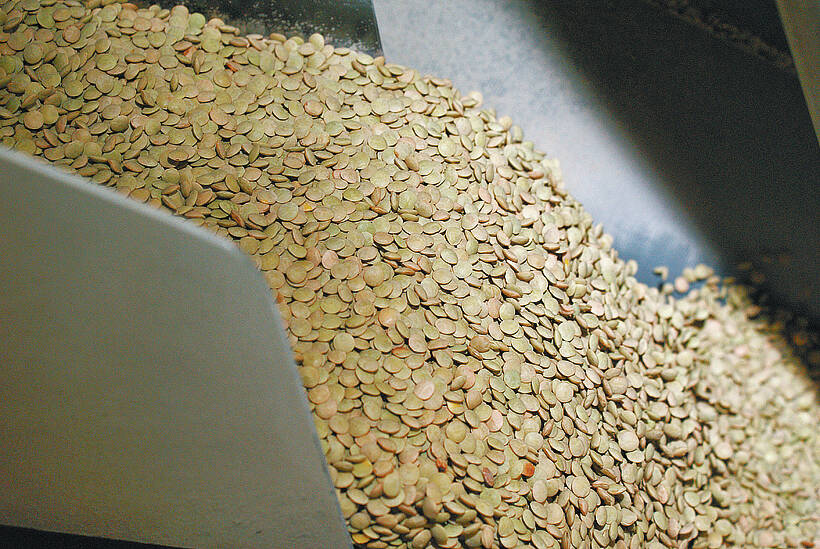Fed cattle prices drop
Fed cattle prices fell all last week following severely lower futures and cut-out meat prices in the United States.
Feedlots are losing money and spirits are down, said Canfax.
Offerings were not large as feedlots continue to clean up old cattle.
A few cattle placed in feedlots in July and August are showing up in the mix and, with fewer days on feed, are expected to lower carcass weights.
American packers were still bidding on cattle, but at prices $2 per hundredweight lower.
Read Also

Green lentil market oversupplied
Farmers in Western Canada can expect price pressure on their new crop of green lentils, as the available supplies among the world’s major lentil-growing nations increase significantly.
Alberta prices Nov. 8 were steers $89-$89.50 per cwt., flat rail $151.65-$152.15 and heifers $90.80-$91.50.
The hotel, restaurant and industrial meat trade remains dismal. With consumers eating more meals at home and not travelling, fewer dollars are being spent on the higher priced middle meats, said Canfax.
Beef supplies are ample and although retail business has been considered good, it can’t make up for all of the decline in food service.
Boxed beef prices are reflecting this more than the limited carcass business, but even so the Montreal wholesale fell $1 per cwt. to $158-$159.
The Calgary market fell by $4 to $5 per cwt., with handyweight steers at $150-$160 and heavyweights at $148-$150.
With U.S. futures and cash market so weak, it is hard to determine where the bottom of the trend will appear, said Canfax.
“Beef needs to start moving in order for the cutouts to bottom, which would lead to a bottom in the cash and help shore up the trade in the futures markets,” Canfax said.
In the West, supplies will tighten over the next two to three weeks, which may help improve the basis levels.
In the feeder market, all classes were lower. Steers were generally $4-$5.50 per cwt. lower while heifers lost $2.25-$3.50.
Price ranges continued wide on all classes as buyers were selective in quality and type. Volumes were four percent lower than last week, but six percent larger than the same week last year.
Slaughter cows lost $1.50 per cwt. on the top end of the range to $64 but the bottom fell $4.
Canfax said feeder prices will continue under pressure as feedlot operators struggle with the declining fed market and negative margins.
Business is starting to pick up in the stock cow trade. Bred cows and heifers were mostly $850-$1,250, some as high as $1,350. Cow-calf pairs sold from $950-$1,550.
Fewer cattle on feed
Total number of cattle on feed in Alberta and Saskatchewan on Nov. 1 was down 10 percent from a year ago at 1.03 million head.
The reasons for the reduction were larger marketings in October and smaller placements.
Placements were down 23 percent from October 2000.
Placements of calves less than 600 pounds were down 33 percent, 600-699 lb. were down 24 percent, 700-799 lb. calves were down seven percent while feeders 800 lb. and heavier were down 18 percent.
The marketing number was up 14 percent, which included a 36 percent increase in fed cattle exports and slaughter increases of three percent on steers, and 19 percent on heifers.
The lower placements were a result of the earlier movement of feeders and calves during August and September due to the drought, said Canfax.
Loonie helps hog prices
More hogs were slaughtered in the U.S. last week, but the pork cutout value was steady.
Hog prices rose at the beginning of the week but then fell.
The Iowa-Minnesota daily direct hog price (mean, 51-52 percent lean, live equivalent) decreased from $39.64 U.S. per cwt. on Nov. 5 to $37.97 per cwt. Nov. 8.
The weak loonie helped to offset the market’s impact on Canadian hog prices and average index 100 prices edged up about one percent, said Manitoba Agriculture.
While the dismal dollar is making it more expensive to import products from the U.S., like corn, it is helping to raise hog prices.
If it hadn’t been for the falling dollar, the average Manitoba hog price last month would have been about three percent below the average a year earlier, instead of up by 1.4 percent.














